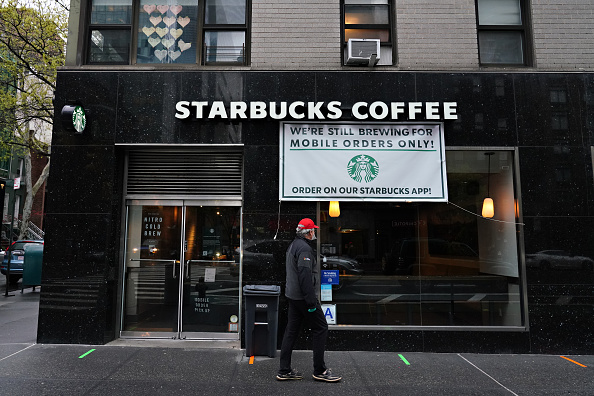Starbucks’ Comeback Strategy Depends on To-Go Orders
Starbucks plans to have most stores open by June, but it’s hardly a return to normal. Stores will rely on to-go orders, and cafes will be closed.
By Chava Gourarie May 1, 2020 10:16 am
reprints
Like a jittery coffee addict anxious for their morning fix, Starbucks investors were eager to hear on this week’s earnings call how the java giant plans to reopen its 15,000 locations as states end their mandated shutdowns.
National coffee chains like Starbucks and Dunkin (aka, Dunkin’ Donuts) have seen dramatic sales decreases, local cafes are boarded up, and third-wave coffee shops are struggling to stay afloat. Unlike some sectors, coffee shops can remain open for pickup and delivery, though that doesn’t in any way guarantee profitability.
But as the biggest coffee chain on the planet, the Seattle-based Starbucks is in a league of its own, and is setting its own course. Thanks to the prevalence of its drive-thru model, close to half of its locations remained open in some capacity, as much of the nation shut down in the wake of the coronavirus pandemic. The company is now preparing to turn it up a notch and will begin reopening stores across most of the United States next week, according to the company’s earnings call, with plans to have more than 90 percent of its stores opened by June 1.
Starbucks has the advantage of experiencing both the coronavirus outbreak and the gradual reopening of the economy in China, where over 98 percent of its stores are now open, though many with limited seating. It even managed to launch a line of plant-based products in China in late April, including Beyond Meat, Oatly oat milk, and plant-based packaging.
However, though Starbucks’ reopening next week is heralded as a comeback, it’s hardly a return to normal. Stores will open for to-go orders only, the cafes will remain closed, and there will be no seating at any locations. At stores without drive-thrus, customers will be able to pick up their orders at the entrance, without going inside, and only 30 stores nationwide will open their interiors initially.
Ironically, the move takes Starbucks backs to its roots, given it was largely responsible for popularizing the to-go coffee in the eighties and nineties, and cementing it as a staple of American culture.
And truth be told, picking up a cup of Starbucks coffee can feel like a luxury these days.
David Firestein, a partner at retail brokerage The Shopping Center Group, who represents Starbucks in many of its New York leases, said his coffee run is the one thing he couldn’t let go of. During quarantine, he and his wife have been driving 20 minutes out of their way to get their daily cup at the nearest Starbucks drive-thru. “We’ve all given up a lot of our routines, so it’s nice to keep some of what we can going,” he said. “And I don’t think we’re alone in that.”
Like all companies, Starbucks has had to contend with the immediate impacts of economic shutdown in response to the coronavirus pandemic: store closures, reduced employment, shifting consumer behaviors, and managing new health and safety protocols. But by virtue of its quick-service model, Starbucks is better positioned than many to adapt to a grab-and-go model, and therefore better situated from a real estate perspective than a lot of food and beverage operators.
While most New York City leasing froze in late March, Starbucks moved forward with a lease agreement to greatly expand its presence at the Empire State Building. That certainly doesn’t signal a contraction of its real estate ambitions, nor any concern about being in New York, the city most heavily battered by COVID-19.
New York has the most Starbucks locations of any city in the world, with over 300 stores across all five boroughs, and is home to a 23,000-square-foot Starbucks roastery/playground, located in the Meatpacking District, one of only three in the United States.
Over the last six weeks, the majority of stores in urban centers like New York have been totally closed, but because of the prevalence of its drive-thru model across the nation, it was able to keep many of its stores open for pickup. By early April, 76 percent of the company’s drive-thrus remained open, a category that makes up 58 percent of all Starbucks-owned stores, and 55 percent of licensed stores remained open, most of them in grocery stores, according to data from Starbucks.
However, with many Americans staying home, those stories did far less business than usual.
Same-store sales declined three percent in the United States, and 31 percent internationally, in the quarter ending March 29, which is the second quarter on Starbucks’ fiscal calendar.
Unlike some restaurant chains, Starbucks ponied up its rent in April, according to a report from Datex Property Solutions. Starbucks had paid 95 percent of its April rent by April 20, up from 89 percent the month before, while Dunkin had paid 70 percent, compared with 80 percent the previous month, according to the report.
Starbucks is also ahead of the curve on employment; Starbucks has provided additional paid leave, and increased hourly wages in an effort to support their employees, according to announcements from the company in March. “I want you to know that here at Starbucks, you should never have to choose between work and taking care of yourself,” Rossann Williams, a Starbucks executive said in a message to employees.
At first, Starbucks offered employees 14 days of paid time off, or catastrophe pay, if they, or someone in their household, were infected. Then in April, it extended catastrophe pay to all employees through May 3, and an extra $3 an hour for anyone who chose to work. While most restaurant chains did not provide their workers with paid sick leave before the coronavirus pandemic, Starbucks was one of the few that did.
However, some employees and industry critics felt that Starbucks wasn’t doing enough to protect them, as stores remained open even when employees were known to have contracted the coronavirus, BuzzFeed reported.
And, as employees are being called back into work in the first week of May, many with limited hours, they remained concerned. “Don’t make us go backkkkk, I’m not ready to get sick! :(,” one barista wrote on a forum for Starbucks employees.
Starbucks plans to train employees on the new health protocols as stores reopen, Starbucks COO Rosalind Brewer said during the second quarter earning call, and will provide masks and temperature checks for employees.
Another advantage that Starbucks has, and an area where it plans to focus, is its online platform. In January, prior to the pandemic, Starbucks reported that it had 18.9 million members in its rewards program, and over 17 percent of sales was driven by mobile orders.
Starbucks had been experimenting with various to-go options and had begun testing mobile-only kiosks, even before the pandemic, said Firestein including one in Penn Station. “If you had this stuff in place prior to, then it works. The ones that tried to do it after the fact, it’s pretty hard.”
That puts companies like Chipotle, Sweetgreen and Starbucks, which have invested heavily in delivery, pickup, and other online revenue streams in a much better position, as consumer behaviors shift in the immediate term, as well as over the lifetime of the pandemic.
While the Penn Station kiosk was a pilot, Firestein says it’s likely we’ll see more of them crop up as one way to deal with the effects of the coronavirus. “They do [mobile-app pickup] within the existing cafes, but they’re just starting to do it in standalone locations,” he said. “We will see a fast forward of that.”
That being said, Starbucks has predicted steep declines through the end of 2020, but expects China to fully rebound by September, according to its earnings call. In order to save on capital, the firm is suspending or deferring some new store openings and renovations. In China, Starbucks plans to open 500 new stores in 2020, 80 percent of the 600 planned.
The outlook for Starbucks, that it will suffer losses in the short run but is on strong footing to rebound from those losses, only serves to highlight how few companies are in its position, with many industries expecting the pandemic to be an extinction event for small businesses.
In addition to independent cafes, Firestein said he’s concerned for smaller coffee chains with several locations, or with locations in multiple markets. “Restaurants with multiple locations, there’s a huge number that will reopen, they just won’t reopen all their locations; they’ll pick their best three,” said Firestein. “Even the ones that reopen, fast forward a year, some percentage will be gone a year later.”
Autumn Stanford is the proprietor of Brooklyn Kolache, a coffee shop in Clinton Hill, named for their specialty, a Texas-style Czech pastry. She’s kept the coffee shop open for pickup and delivery, with very limited hours, for now. “Everything is still up in the air, as far as how will make it through,” she said.
Stanford has managed to negotiate an agreement with her landlords over rent, and has laid off most of her staff so they can collect unemployment. She did not apply for the Paycheck Protection Program because she doesn’t know if she can hire back her employees by June 30, and reopening at limited capacity is hardly a solution. “Opening your restaurant at quarter- or half-capacity will probably bankrupt you faster than being closed,” she said. “The only time you can really make money is when you have fast turnover and you’re at full capacity.”
Many independent restaurants across the country have called for federal relief targeted specifically at their industry. “It’s going to have to happen whether we lobby for it or not,” Stanford said. “I don’t think our economy can handle losing all our small restaurants.”
Nor could the hordes of coffee lovers, as well.


